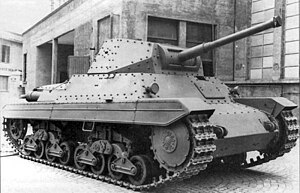| Carro Armato P 26/40 | |
|---|---|
 P26/40 tank in Fiat-Ansaldo factory. | |
| Type | Heavy tank/Medium tank |
| Place of origin | Italy |
| Service history | |
| Used by | Italian Social Republic Germany Italian resistance movement (Captured)[1] |
| Wars | World War II |
| Production history | |
| Designed | 1940–1943 |
| Manufacturer | Ansaldo |
| Produced | 1943–1944 |
| No. built | 103 or 110/120 |
| Specifications | |
| Mass | 26 tonnes |
| Length | 5.80 m (19 ft 0 in) |
| Width | 2.80 m (9 ft 2 in) |
| Height | 2.5 m (8 ft 2 in) |
| Crew | 4 (commander/gunner, loader, driver, radio-operator) |
| Armour | Turret: front 60 mm (2.4 in), sides and rear 45 mm (1.8 in), top 20 mm (0.8 in) Hull: front 50 mm (2.0 in), sides 45 mm (1.8 in) and rear 40 mm (1.6 in), bottom 14 mm (0.6 in) |
Main armament | Ansaldo 75 mm L/34 gun |
Secondary armament | 1-2 × 8 mm Breda 38 machine guns |
| Engine | V-12 SPA 342 diesel, 24 litre 330 hp (243 kW)[2] |
| Power/weight | 11.53 hp/tonne |
| Suspension | Semi-elliptical leaf spring bogies |
Operational range | 280 km (170 mi) |
| Maximum speed | 40 km/h (25 mph) road 25 km/h (16 mph) off-road |
The P 26/40 was an Italian World War II heavy tank (sometimes defined medium tank when compared to tanks of other nations). It was armed with a 75 mm gun and an 8 mm Breda machine gun, plus another optional machine gun in an anti-aircraft mount.[3] Design had started in 1940 but very few had been built by the time Italy signed the armistice with the Allies in September 1943 and the few produced afterwards were used by the Germans.[4]
The official Italian designation was carro armato ("armoured vehicle") P 26/40. The designation means: P for pesante ("heavy"), the weight of 26 tonnes, and the year of adoption (1940).[5] While considered a heavy tank according to Italy's standards, the P26/40 was much more similar in performance to the medium tanks of other nations.
- ^ Comando Supremo. Gruppo Corazzato Leoncello (Armored Group Leoncello)
- ^ Cappellano & Battistelli, 2012, p48
- ^ H, Jim (7 March 2010). "Carro Armato P26/40: Italian Heavy Tank". Comando Supremo. Retrieved 10 December 2021.
- ^ "Carro Armato P40 (Carro Pesante P40)". www.militaryfactory.com. Retrieved 10 December 2021.
- ^ Cappellano, F; Battistelli, P P (2012). Italian Heavy tanks : 1939-45. Oxford: Osprey Publ. pp. 5, 17. ISBN 9781849087766.